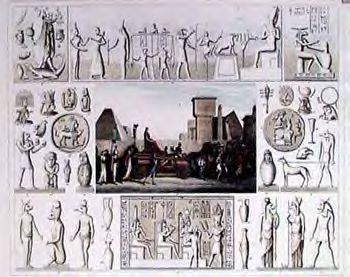More than 70,000 years before the birth of Christ, paleolithic peoples existed on the breast of what we now know is the Nile. In this plush land, filled with game and plant life, mineral and metal deposits, the ancients built simple dwellings, made tools, used fire, cured skins and buried their dead. In this place, a wonderful society was built.
With time and endless ages, the land became drier and the deserts grew, sheltering this vital society from the rest of the world. 7,000 years before the birth of Christ, these societies began to breed animals, refine their crafts and skills and, doubtless, they began to spawn their own belief systems. These societies lay in isolated pockets, following their own beliefs and practices untill two main divisions in the land dominated all others--They were Lower Egypt and Upper Egypt, or Kemet as the land was called.
Only the strongest and their offspring or their designees could control and rule this diverse, rich and complicated land. Here are the names of the leaders, the Pharaohs, the kings and queens of this powerful land . . .
Throughout the the centuries, when Pharaohs ruled the ancient land, Egypt has played host to the gods. As the ancient tribes, villages, grew to become organized communities, cities and, then nomes, each locality contributed a part of its belief system and some of it's gods to the religious structure of greater Egypt. The ancients did not like to discard their gods for new ones, rather when exposed to another influential god, they were as likely to combine the new gods traits, with those of local deity and the name of the new, hybrid god would be an amalgam of the old and new. As part of their religious philosophy, they granted that all animals, humans and all aspects of nature were endowed with life force-Thus, some of the greatest of the pantheons of Egyptian gods took on animal form or had acquired the attributes of revered or feared animals.
At the center of all religious belief, was the absolute belief in the need for a balance, an equalizing force in all matters. The ancients believed that the needs of humankind must be balanced with those of nature-that for every action, there was an opposing reaction. The ancients feared chaos above all and believed in Ma'at, the balance between all things.
The story of ancient Egypt, is the story of a people and their relationship to their land. The character and belief systems derive from the land.
The land was called Kemet, it consisted, as it does today, of two main areas--The desert, or the red land and the nutrient rich, cultivable land, called, the black land. Pharaohs, the ultimate authority in ancient Egypt, were called Lord of the Two Lands.
The land, bordered by the Mediterranean Ocean, the Red Sea, was dominated by an inland source of water, that ran south to north, the river, Nile. The cooling waters quenched the thirst, fed the hunger of the ancient people. The Nile was constant.
The Nile was so steady, so predictable, that early scientists devised ways to measure the Nile at scheduled intervals, by means of a device called a Nilometer. With these measurements, engineers could predict the level of the waters at its height, so that preparations could be made for the season of high water. Irrigation canals and runoffs diverted, widened or otherwise prepared so that the mineral enriched silt, born by the waters of the Nile, could best be absorbed by the land.
The land would be tilled and crop yields maximized. Excess crops were dried and stored in granaries for the dry season, that follows the floods. This was the rhythm of the seasons, the interplay of the land and the waters and the people absorbed the rhythm and worshipped the balance that held their universe.
In the Eastern Desert, semi-precious stones were mined--Crystal, jaspers, garnets and carnelians. There were deposits of gold and silver and an alloy, electrum. Bronze and copper were mined in this expanse until supplies diminished in the Middle Kingdom, when Egypt traded for the ore, with Cyprus and Syria.
The naturally occurring salt, natron, was abundant in the desert. Natron, of couse, was used to desicate the mortal remains of the deceased during mummification, but likewise was used to cure hides, preserve meat and fish and in the preparation of medicines and the manufacture of glass and faience jewelry. Priests in the temples used the salt to purifiy their mouths before approaching the gods; women in the villages used a variety of the commodity to wash their clothes.
|

House of J'Atar Allies: House of Y'Alla
Kingdom of Ballicastle
Kingdom of Heathfield
Kingdom of Innis Daingneach
Isle of Cyprus
|
 Nahkt font used, get here
Nahkt font used, get here